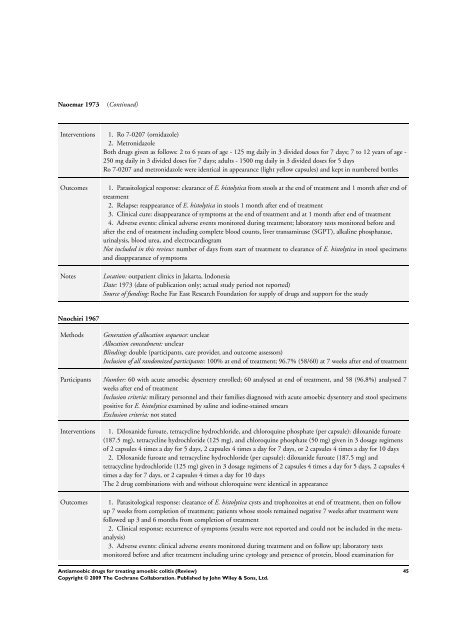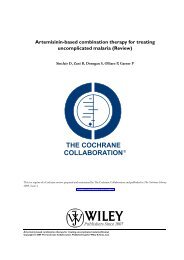Antiamoebic drugs for treating amoebic colitis - The Cochrane Library
Antiamoebic drugs for treating amoebic colitis - The Cochrane Library
Antiamoebic drugs for treating amoebic colitis - The Cochrane Library
Create successful ePaper yourself
Turn your PDF publications into a flip-book with our unique Google optimized e-Paper software.
Naoemar 1973 (Continued)<br />
Interventions 1. Ro 7-0207 (ornidazole)<br />
2. Metronidazole<br />
Both <strong>drugs</strong> given as follows: 2 to 6 years of age - 125 mg daily in 3 divided doses <strong>for</strong> 7 days; 7 to 12 years of age -<br />
250 mg daily in 3 divided doses <strong>for</strong> 7 days; adults - 1500 mg daily in 3 divided doses <strong>for</strong> 5 days<br />
Ro 7-0207 and metronidazole were identical in appearance (light yellow capsules) and kept in numbered bottles<br />
Outcomes 1. Parasitological response: clearance of E. histolytica from stools at the end of treatment and 1 month after end of<br />
treatment<br />
2. Relapse: reappearance of E. histolytica in stools 1 month after end of treatment<br />
3. Clinical cure: disappearance of symptoms at the end of treatment and at 1 month after end of treatment<br />
4. Adverse events: clinical adverse events monitored during treatment; laboratory tests monitored be<strong>for</strong>e and<br />
after the end of treatment including complete blood counts, liver transaminase (SGPT), alkaline phosphatase,<br />
urinalysis, blood urea, and electrocardiogram<br />
Not included in this review: number of days from start of treatment to clearance of E. histolytica in stool specimens<br />
and disappearance of symptoms<br />
Notes Location: outpatient clinics in Jakarta, Indonesia<br />
Date: 1973 (date of publication only; actual study period not reported)<br />
Source of funding: Roche Far East Research Foundation <strong>for</strong> supply of <strong>drugs</strong> and support <strong>for</strong> the study<br />
Nnochiri 1967<br />
Methods Generation of allocation sequence: unclear<br />
Allocation concealment: unclear<br />
Blinding: double (participants, care provider, and outcome assessors)<br />
Inclusion of all randomized participants: 100% at end of treatment; 96.7% (58/60) at 7 weeks after end of treatment<br />
Participants Number: 60 with acute <strong>amoebic</strong> dysentery enrolled; 60 analysed at end of treatment, and 58 (96.8%) analysed 7<br />
weeks after end of treatment<br />
Inclusion criteria: military personnel and their families diagnosed with acute <strong>amoebic</strong> dysentery and stool specimens<br />
positive <strong>for</strong> E. histolytica examined by saline and iodine-stained smears<br />
Exclusion criteria: not stated<br />
Interventions 1. Diloxanide furoate, tetracycline hydrochloride, and chloroquine phosphate (per capsule): diloxanide furoate<br />
(187.5 mg), tetracycline hydrochloride (125 mg), and chloroquine phosphate (50 mg) given in 3 dosage regimens<br />
of 2 capsules 4 times a day <strong>for</strong> 5 days, 2 capsules 4 times a day <strong>for</strong> 7 days, or 2 capsules 4 times a day <strong>for</strong> 10 days<br />
2. Diloxanide furoate and tetracycline hydrochloride (per capsule): diloxanide furoate (187.5 mg) and<br />
tetracycline hydrochloride (125 mg) given in 3 dosage regimens of 2 capsules 4 times a day <strong>for</strong> 5 days, 2 capsules 4<br />
times a day <strong>for</strong> 7 days, or 2 capsules 4 times a day <strong>for</strong> 10 days<br />
<strong>The</strong> 2 drug combinations with and without chloroquine were identical in appearance<br />
Outcomes 1. Parasitological response: clearance of E. histolytica cysts and trophozoites at end of treatment, then on follow<br />
up 7 weeks from completion of treatment; patients whose stools remained negative 7 weeks after treatment were<br />
followed up 3 and 6 months from completion of treatment<br />
2. Clinical response: recurrence of symptoms (results were not reported and could not be included in the metaanalysis)<br />
3. Adverse events: clinical adverse events monitored during treatment and on follow up; laboratory tests<br />
monitored be<strong>for</strong>e and after treatment including urine cytology and presence of protein, blood examination <strong>for</strong><br />
<strong>Anti<strong>amoebic</strong></strong> <strong>drugs</strong> <strong>for</strong> <strong>treating</strong> <strong>amoebic</strong> <strong>colitis</strong> (Review)<br />
Copyright © 2009 <strong>The</strong> <strong>Cochrane</strong> Collaboration. Published by John Wiley & Sons, Ltd.<br />
45








